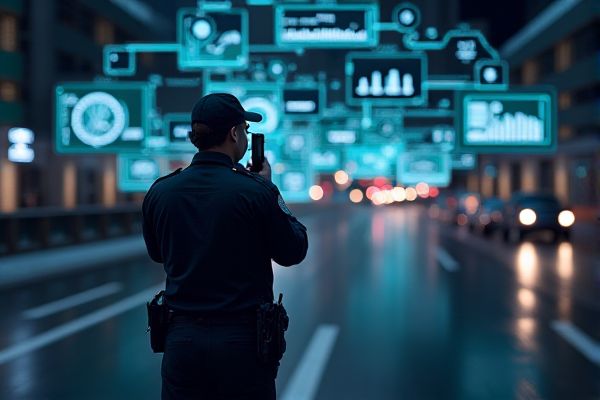
Artificial intelligence enhances law enforcement investigations by analyzing vast amounts of data to identify patterns and trends. Algorithms can sift through surveillance footage, social media posts, and public records, leading to faster identification of suspects and potential leads. Predictive policing tools leverage historical crime data to allocate resources more effectively, improving response times and crime prevention strategies. AI technologies also assist in forensic analysis, such as facial recognition and voice analysis, increasing the accuracy of evidence collection.
AI usage in law enforcement investigations
Predictive Policing Algorithms
Predictive policing algorithms analyze historical crime data to identify potential hotspots for criminal activity. Agencies like the Los Angeles Police Department use these tools to allocate resources more effectively. The likelihood of reducing crime rates increases with the strategic deployment of officers in identified areas. However, the effectiveness of such algorithms can vary based on the quality of the underlying data.
Facial Recognition Technology
AI usage in law enforcement investigations can enhance the efficiency and accuracy of identifying suspects or missing persons. Facial Recognition Technology (FRT) offers a promising tool for quickly matching surveillance footage with databases, potentially increasing the success rate of investigations. By integrating machine learning algorithms, law enforcement agencies can analyze vast amounts of data in a fraction of the time it would take manually. The collaboration with technology firms specializing in biometric solutions could further improve these investigative processes.
Crime Pattern Analysis
AI can enhance crime pattern analysis by identifying trends and anomalies in large datasets. Law enforcement agencies can leverage AI algorithms to predict potential hotspots for criminal activity, improving resource allocation. For example, the Los Angeles Police Department uses predictive policing tools to anticipate where crimes are likely to occur. This application of AI may lead to a more proactive approach in preventing crime and enhancing community safety.
Automated Surveillance Systems
AI usage in law enforcement investigations could enhance efficiency by analyzing vast amounts of data quickly. Automated surveillance systems could help identify patterns in criminal behavior and improve response times. The integration of systems like facial recognition could provide law enforcement with the tools to solve cases more effectively. These advancements may lead to a reduction in crime rates and improved public safety.
AI-Driven Social Media Monitoring
AI usage in law enforcement investigations can enhance the efficiency of criminal case analysis by quickly processing large volumes of data. AI-driven social media monitoring allows agencies to track potential threats and gather intelligence from public online platforms. For example, the integration of AI tools such as facial recognition software might aid in identifying suspects more rapidly. This technological advancement presents the possibility of reducing response times and improving overall public safety.
Natural Language Processing for Forensic Analysis
AI can enhance law enforcement investigations by streamlining data processing and analysis. Natural Language Processing (NLP) can assist in forensic analysis by interpreting large volumes of textual evidence, such as police reports and witness statements. By improving the accuracy of information extraction, NLP may lead to quicker case resolutions. For example, utilizing AI tools can potentially increase the efficiency of investigations conducted by agencies like the Federal Bureau of Investigation (FBI).
Risk Assessment Tools
AI usage in law enforcement investigations can enhance efficiency and accuracy in analyzing large volumes of data. Risk assessment tools, for instance, help in predicting the likelihood of reoffending by evaluating various factors related to a suspect's background. These technologies may provide insights that assist officers in prioritizing cases or deploying resources more effectively. The potential to improve decision-making processes could lead to enhanced public safety outcomes.
Data Fusion and Integration
AI technology can enhance law enforcement investigations by improving data analysis and decision-making processes. For example, AI systems can integrate data from various sources, such as criminal records and surveillance footage, to identify patterns and suspects more effectively. This integration allows officers to allocate resources based on real-time insights, potentially increasing the chances of solving cases. The use of data fusion could lead to more efficient investigations and better outcomes for public safety efforts.
Digital Evidence Management
AI can enhance law enforcement investigations by streamlining digital evidence management. For example, the integration of AI algorithms can help in categorizing large volumes of data collected from various sources, making crucial information more accessible. This technological advancement can improve the efficiency of evidence retrieval, ultimately aiding in quicker case resolutions. Organizations like the FBI are exploring such innovations to modernize their investigative processes.
Bias and Ethical Implications Evaluation
AI usage in law enforcement can enhance investigative efficiency by analyzing large datasets for patterns. For example, predictive policing algorithms might assist departments like the LAPD in resource allocation. However, reliance on AI raises concerns regarding bias, particularly if training data reflects historical injustices. Ethical implications must be thoroughly evaluated to ensure fair and just outcomes for all communities involved.
 techknowy.com
techknowy.com